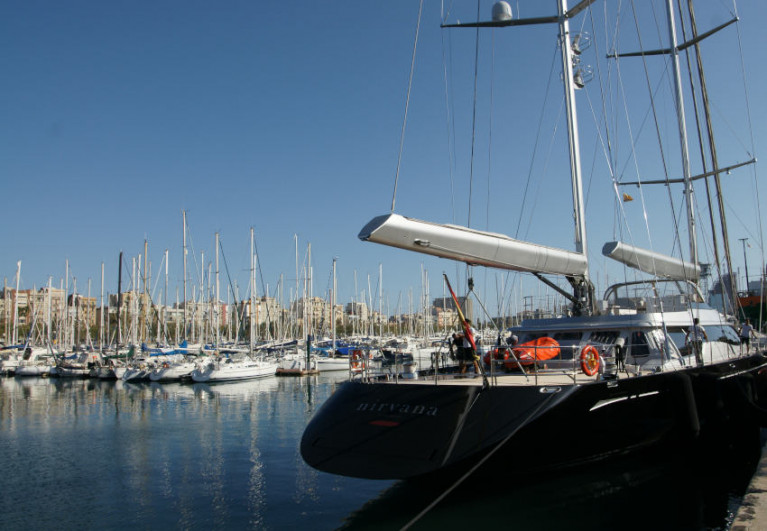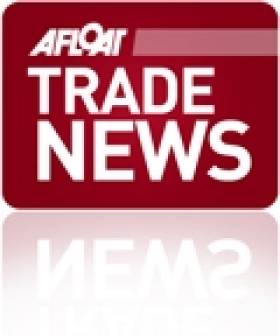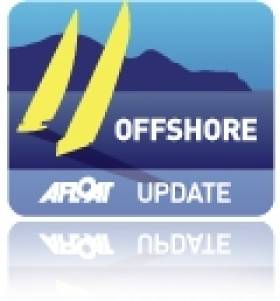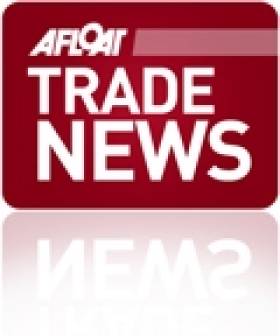Displaying items by tag: Barcelona
America’s Cup: Alinghi Red Bull Racing Capsizes in First Sail at Barcelona
There were highs and lows for Alinghi Red Bull Racing in Barcelona on Wednesday (31 August) as after a successful first day of sailing in the America’s Cup venue, their AC75 capsized in a violent rain squall, as Marine Industry News reports.
The team explained on social media that while towing back with sails down, the boat bounced into the wind and was pushed on to her side.
Some of the crew members were knocked overboard but were promptly recovered by the support team and everyone returned safe and sound to the team base, the team added.
Silvio Arrivabene, co-general manager of Alinghi Red Bull Racing later confirmed that Boat Zero had “suffered minor damage to the port foil arm and to the hull” but added: “We will be back on the water soon, carrying on with our preparation for the 37th America’s Cup.”
Alinghi Red Bull Racing will represent the Société Nautique de Genève as a Challenger for the 37th America’s Cup in Barcelona in 2024.
Marine Industry News has more on the story HERE.
Former Volvo Ocean Race Sailor Dies In Incident At Spanish Marina
An Australian sailor who took part in the former Volvo Ocean Race has died in an incident in a Spanish marina before the New Year.
Metro.co.uk reports that the body of 37-year-old Zane Gills was found under the yacht he had sailed with his brother into Port Vell in Barcelona ahead of New Year’s Eve.
It’s understood that Zane’s brother left him on board to run an errand but on return there was no sign of the professional sailor, who was bowman for Team Telefonica in the 2011-12 Volvo Ocean Race that climaxed in Galway.
Zane was also a foiling sailor, taking part in the 2018 Moth Worlds alongside Ireland’s David Kenefick and Rory Fitzpatrick, and was part of the Desafío MAPFRE offshore team, which was among those paying tribute from the world of sailing.
Metro.co.uk has more on the story HERE.
Celebrations for Five Decades of the Barcelona Boat Show
In June 1963, a group of personalities who are linked to sports and the nautical industry, with Juan Antonio Samaranch at the forefront and the support of Fira de Barcelona, set up the first edition of the Barcelona Boat Show. The event, which is celebrating its 50th anniversary, has had a long and successful run and is, today, the sector's biggest commercial platform in Spain, its main meeting point and an international leader.
The Barcelona Boat Show is created in 1963 with the aim of boosting the sports and recreational nautical industry and promoting nautical sports. At the time, there are only a few specialised companies and marinas and an absolute lack of knowledge among the Spanish population about the possibilities of navigation. Nonetheless, thanks to the enthusiasm and drive of a group of people passionate about boating and the few professionals that existed at the time, the show manages to open its doors successfully with the participation of 150 exhibiting companies in hall 1 of Fira de Barcelona's Montjuïc exhibition centre.
After the success of the first edition, which took place within the framework of the very popular Feria de Muestras, it was agreed that the show would be an annual monographic event. In 1965, in the international category, it starts to exercise its role as a voice for the concerns of the sector, a function it has maintained until today.
Only two years later, in 1967, the nautical industry's first major boom takes place: new ports are opened, boats are built with their own design or under licence from foreign shipyards, boats can be seen in the sea, wood starts to give way too fibre glass and ranges grow considerably. In line with this development, the show sees a significant increase in exhibitors in 1969 and its organising committee prioritizes the growth of young people's enthusiasm for the sea -the appearance of the Optimist in '68 being crucial to this.
The sector undertakes actions to raise the government's awareness of the importance of carrying out reforms on registration procedures and taxation, with the aim of boosting an industry and trade that are forecast to grow and generate wealth and jobs for the country. The same year, the Law of Marinas is enacted; this is a basic toll for the expansion of the nautical industry in Spain and is considered to be one the Boat Show's most important contributions to the sector.
The 70s: the boom of tourism and nautical sports
The sector becomes more and more professional and, in the 70s, there is a notable increase in enthusiasts, although the figures show a big gap between Spain and other countries. For example, while in Spain the ratio is one boat for each 1,500 inhabitants, in Italy it is one per 192 and, in Scandinavian countries, it is one per 62. In any case, the government gives signs of its interest in the sector and the show; and in 1973, it grants it the golden plaque for tourist merit, aware of the importance of nautical tourism in Spain.
The show also continues to reinforce its sports aspect as a complement to its commercial side. Boat Show Trophy Races are organised and awards are given to the best sportspersons of the year, such as the Spanish Optimist team, which become World Champions in the races held in Sweden.
Ecology starts to make an appearance with the exhibition of the Dephins, the first electric engines. In 1976, the event receives the name of "International Boat and Sports Show" and opens up to the camping and caravanning sector. Samaranch, who has been president of the show since its beginnings, leaves the post in 1978, having been appointed Spain's ambassador in the Soviet Union and Outer Mongolia. He is replaced by Jacinto Ballesté, also member of the founding team. In 1979, the Asociación Española de Puertos Deportivos y Turismo is founded and its secretariat is installed in the Boat Show with Jorge Salvat at the helm. This represents one further step in the sector's development.
The 80s: the popularisation of nautical activities
The 80s bring many changes and innovations: the foundations to make the show more international are laid, it is split into sectors and the dates are brought forward in order to allow shipyards to programme their purchases and production. These changes are positive for the event, which sees the number of exhibitors and exhibition floor space grow, up to the middle of this decade. New nautical sports, such as windsurfing, take off and the first solar panels to be installed on board are exhibited. Boat charters and hire start to have a place in the show, with proposals to attract a public eager to navigate but unable to afford a boat of their own.
The number of new products presented by exhibitors also increases. Electronic equipment becomes smaller and cheaper and bow propellers for medium-length boats are introduced, making it easier to dock and cast off.
Activities to bring the public into contact with the nautical world increase, with navigation courses, steering with a tow, submarine photograph contests, navigational simulators, announcement of races, etc. Associations, federations, and institutions hold more and more assemblies, juntas and meetings within the setting of the show. In short, the show, which receives the Creu de Sant Jordi (Saint Georges' Cross) from the Generalitat de Catalunya in 1988, is confirmed as the sector's meeting point.
The 90s: the first on-water show
The 90s start with optimism. In 1992, the Barcelona Olympic Games are held, which represents a turning point for tourism, including the nautical industry: charter companies are consolidated and new marinas are built.
The number of motor boats at the show increases, especially large units and fisher-cruisers, as do new products presented by exhibitors; new materials, such as the composite, the latest design and equipment proposals and the latest technological advances, above all in the field of electronics, are exhibited. The concepts of sustainability and ecology take hold in the nautical world, even in recreational fishing.
The show is also consolidated as the meeting point for the sector, which is more and more professionalized, taking its concerns to the administration via the new associations that continue to arise. It also becomes a setting for the announcement of important races.
Nonetheless, during this decade, the show's main new feature is its arrival at the sea. As an addition to the Montjuïc exhibition centre, in 1995, Port Vell is set up for the first time to provide the setting for the On-Water Show with larger national and international boats. The same year, Jordi Montserrat takes over from Miguel Rafart as director of the show. In 1998, Fira de Barcelona's Administrative Board appoints Jorge Salvat as President Emeritus, after having been the show's president for 19 editions. He is replaced by the well-known impresario Enrique Puig.
A new century: the number of nautical enthusiasts grows
Enthusiasm for nautical activities multiplies and the show begins to develop in spectacular fashion. One of the highlights occurs in 2002, coinciding with the disappearance of the peseta and the introduction of the euro: the event moves to the new, modern Gran Via exhibition centre, maintaining the On-Water Show in Port Vell. In response to sector demands, the dates are also changed to the first week in November, in order to give continuity and avoid coinciding with other international shows.
Between 2002 and 2007, the Boat Show continues to grow, boosting the leisure activities and nautical sports sectors and showcasing national and world premiers. It is also the venue for meetings of international organisations with the presence of personalities related to the nautical industry from around the world, such as the International Sailing Federation (2003). New organisations are created within the show's framework, such as the Asociación Española de Clubes Náuticos and the Asociación Nacional de Empresas Náuticas, ANEN (2006). In 2007, Jordi Freixas is appointed new director of the show to replace Jordi Montserrat.
After years of optimism, the sector begins to show signs of recession in 2008, which leads to concern that a world scale economic crisis is on the horizon. That year, Enrique Puig, the show's president, passes away and, for that edition, the president emeritus, Jorge Salvat, steps in. In 2009, Luis Conde is appointed the new president.
From that year, the effects of the crisis are heightened. Until now, the show has been carrying out actions to support companies, reinforcing its role as the main platform for energising trade and the sector's main setting, from which to express its needs and look for solutions to tackle the difficult economic situation.
Despite the recession, nautical companies have stood out for their efforts and commitment to technological innovation with the development of new, safer, sustainable and environmentally-friendly products. At the same time, lovers of the sea, who continue to grow in numbers, are looking for new formulas via which to enjoy the sea, and interest in charter and shared property is growing.
Foxall Recalls Barcelona Race
The pair set an inaugural course record of 92 days, 9 hours, 49 minutes and 49 seconds over the round the world route, although the first edition of the race began earlier in the year – on November 11, 2007.
Foxall is currently immersed in another round-the-world project, as part of the Groupama team preparing for their entry in the 2011-12 Volvo Ocean Race – his fourth participation in the race. With less than 24 hours to go until the start of the second edition, they asked him to cast his mind back to the Barcelona World RACE start:
What feelings do you have looking back at this pre-start period of the Barcelona World RACE?
"Like any oceanic race it's an accumulation of a huge amount of effort in terms of just getting the project to the startline. The race is quite often just the end part of what is quite a long process by the skippers to realise the boat's potential, along with the shore team and the designer and the sail designers. And to a certain extent for a lot of them they'll have had the resources and time to put a bit of the writing on the wall already, in other words to arrive with the very best boat and the very best possible team they can.
"Of course what happens over the next three months might end up telling a different story but most of the guys will hope they already have done what they can to have the best boat and the best possible outcome in the race."
What is your assessment of the fleet, who are your favourites to win?
"I think Jean Pierre Dick and Loick Peyron on Virbac-Paprec 3 are of course going to be one of the favourites, they've got various successes with the Transat Jacques Vabre together, and each have more and more. I certainly hope for the best and wish good things for them.
"It's actually quite an impressive line up with Michel Desjoyeaux and Foncia, and I'm sure that will be one of the main boats Jean-Pierre and Loick have to contend with. I think Groupe Bel will have a very, very good team as well, though they're possibly less well known to the general public outside of France.
"I'm not sure what stage Alex Thomson is at, but I think that was a very good pairing with Andrew Meikeljohn. I've sailed a lot with Andy and I'm sure whatever happens they would have had a good time.
"Jean-Pierre and I had been working towards doing it again when other projects came up, and I'm pretty sure if it wasn't for the Volvo Ocean Race I'd be there this time. So I'll be rooting for my home team and hope their new boat proves fast and reliable. I know they're both more than capable of delivering the goods."
Were there any favourite moments of the race for you when you'll be thinking about the skippers in this edition?
"The halfway mark is quite an experience. By that stage there's a certain amount of writing on the wall and you're hopefully well into your stride. Halfway round the world you've settled into a rhythm and you know what your boat is capable of, you know what the other boats are capable of and so I think it's a fairly significant moment. When you go through the Cook Strait and you look east into the Southern Ocean and you're halfway round the world that's quite a memorable mark of the course I guess.
"Obviously Cape Horn is a classic. But I think the biggest memory for me was coming back, the last stage into Barcelona and the contrast from three months at sea and coming back to modern life makes quite an impression, and especially so for us, winning the first edition. It's a great landmark for all of us to come back in."
Is there anything you took from the race you'd pass on to the skippers heading out tomorrow?
"It's a huge challenge and most of the skippers who are there have either been there before or have similar experience to myself so I'm not sure I'd pass on anything that the guys don't already know.
"But it's a long way, it's three months at sea, and unlike the Vendée Globe you're going to sea with somebody else, and it's not like the Volvo where you've got a larger group of people. You're going to sea with one other person and that's probably the most important aspect in terms of the race.
"On the one hand it's the biggest attribute you've got, your buddy, your co-skipper. And it's really important to make that relationship work well and to understand what they need, and to maintain a single objective in common that you both agree on and to basically cross the line having achieved that goal. For some it might be winning, for some it might be just finishing the race, but that common objective is probably the single most important thing that the skippers need to agree on before the start."
Barcelona Boat Show to be Staged from 6-14 November
The next Barcelona International Boat Show will be held from the 6th to the 14th of November 2010 in the Gran Via venue and Barcelona’s Port Vell, will host the On-Water Show.

































































